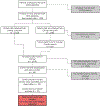Clinical implications of conflicting variant interpretations in the cancer genetics clinic
- PMID: 37057674
- PMCID: PMC10416421
- DOI: 10.1016/j.gim.2023.100837
Clinical implications of conflicting variant interpretations in the cancer genetics clinic
Abstract
Purpose: The aim of this study was to describe the clinical impact of commercial laboratories issuing conflicting classifications of genetic variants.
Methods: Results from 2000 patients undergoing a multigene hereditary cancer panel by a single laboratory were analyzed. Clinically significant discrepancies between the laboratory-provided test reports and other major commercial laboratories were identified, including differences between pathogenic/likely pathogenic and variant of uncertain significance (VUS) classifications, via review of ClinVar archives. For patients carrying a VUS, clinical documentation was assessed for evidence of provider awareness of the conflict.
Results: Fifty of 975 (5.1%) patients with non-negative results carried a variant with a clinically significant conflict, 19 with a pathogenic/likely pathogenic variant reported in APC or MUTYH, and 31 with a VUS reported in CDKN2A, CHEK2, MLH1, MSH2, MUTYH, RAD51C, or TP53. Only 10 of 28 (36%) patients with a VUS with a clinically significant conflict had a documented discussion by a provider about the conflict. Discrepant counseling strategies were used for different patients with the same variant. Among patients with a CDKN2A variant or a monoallelic MUTYH variant, providers were significantly more likely to make recommendations based on the laboratory-reported classification.
Conclusion: Our findings highlight the frequency of variant interpretation discrepancies and importance of clinician awareness. Guidance is needed on managing patients with discrepant variants to support accurate risk assessment.
Keywords: Cancer genetics; ClinVar; Conflicting variant interpretation; Genetic counseling; Variant interpretation discrepancy.
Copyright © 2023 American College of Medical Genetics and Genomics. Published by Elsevier Inc. All rights reserved.
Conflict of interest statement
Conflict of Interest Gregory E. Idos reports research funding from Myriad Genetics (Inst). Jason A. Zell serves in a consulting role for Tempus. Charité N. Ricker reports research funding from Myriad Genetics (Inst). Kevin J. McDonnell has served in a consulting or advisory role for Brogent International and reports research funding from Myriad Genetics. Uri Ladabaum serves as an advisor for Universal Dx, Lean Medical, Kohler Ventures, Vivante, and a consultant for Freenome, Guardant, Medtronic, Neptune Medical, Medial EarlySign. Stephen B. Gruber reports that he is co-founder with equity with Brogent International. Giovanni Parimigiani reports that he holds equity as a co-founder in Phaeno Biotechnologies, is on the SAB of Realm Idx (which owns Ambry Genetics) and currently consults for Delphi Diagnostics and (pro bono) for Martingale Labs. He also co-leads the BayesMendel laboratory, which licenses the BayesMendel package which include several ML tools for the computation of carrier probability of cancer susceptibility genes and future cancer risk. He does not derive any personal income from these licenses. Danielle Braun co-leads the BayesMendel lab, which develops and maintains the BayesMendel software package. This includes a variety of risk assessment tools, including BRCAPRO, PancPRO, MelaPRO, MMRpro and is licensed for commercial use. All other authors declare no conflicts of interest.
Figures



References
-
- Richards S, Aziz N, Bale S, et al. Standards and guidelines for the interpretation of sequence variants: a joint consensus recommendation of the American College of Medical Genetics and Genomics and the Association for Molecular Pathology. Genetics in medicine : official journal of the American College of Medical Genetics 2015;17(5):405–424. - PMC - PubMed
-
- NCCN. Genetic/Familial High-Risk Assessment: Breast, Ovarian, and Pancreatic (Version 1.2022) 2021. (August 11th, 2021). https://www.nccn.org/professionals/physician_gls/pdf/genetics_bop.pdf. - PubMed
-
- NCCN. NCCN Genetic/Familial High-Risk Assessment: Colorectal 2021.
-
- Lindor NM, Petersen GM, Hadley DW, et al. Recommendations for the care of individuals with an inherited predisposition to Lynch syndrome: a systematic review. JAMA-J Am Med Assoc 2006;296(12):1507–1517. - PubMed
Publication types
MeSH terms
Grants and funding
LinkOut - more resources
Full Text Sources
Medical
Research Materials
Miscellaneous

